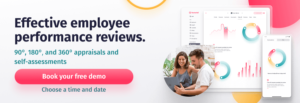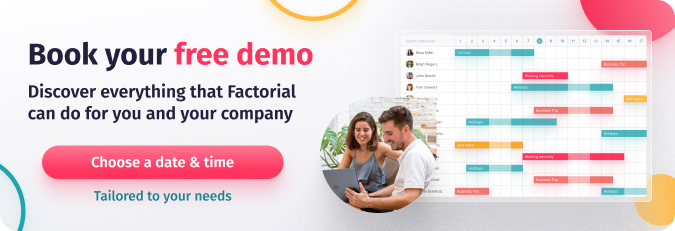A company is only as good as its employees. For this reason, efficient management of employee development and performance appraisals is crucial for long-term growth. However, as a manager, it can often be hard to find time to keep up-to-date with individual performance reviews, KPI progress, and goals. Performance management System, and the tools, apps, and software related to these tasks can help keep employees on track. They not only help streamline your processes but also manage your reviews and automate the steps as much as possible.
TABLE OF CONTENTS
What is Performance Management Software
Main Characteristics of Effective Performance Management Tools
HR Guide to a Performance Management System
Benefits of Employee Performance Appraisals
Performance Management Software ✅
What is Performance Management Software
A performance management system is a user-friendly tool that helps companies better understand and manage the performance of their employees. It enables HR departments to set individual and team goals that align with the aims and values of the company, and it motivates employees with the strategic development of their skills. A good employee performance management system helps human resources managers track and evaluate employee performance against established KPIs and provides employees with relevant training and professional guidance. Solutions usually include features for tracking and monitoring progress, reviews, reporting, goal setting, real-time feedback, and rewards for improved performance.
Traditional performance review systems?
Although some might argue that it is time to move on from traditional performance review systems, the general consensus says otherwise. A good business performance management solution helps HR departments create and communicate clear performance goals for departments and individuals. With this system in place, employees have a clear understanding of what is expected of them.
Key Features and Functions
Objectives and Goal Setting
Without a clear vision of what you wish to achieve, progress will be limited. The key to integrated performance management lies in setting concrete department goals that not only motivate employees but also align with the organization’s overall objectives. Proper planning is vital to enhance productivity, and it starts with clarifying your desired outcomes.
Communication
Effective communication is the cornerstone of successful performance management. Building strong bonds with your team through communication fosters a supportive environment of openness and trust. Regularly following up on previously set strategic goals is essential to assess progress and identify areas for improvement. Addressing shortcomings promptly can prevent issues from escalating until the next performance review.
System of Feedback
A critical component of performance management is providing detailed feedback and suggestions to employees for improvement. Regular feedback empowers employees to enhance their performance and contribute to the overall success of the company.
Reviewing Employee Performance
Conduct quarterly or annual performance reviews based on your company’s size and structure. These reviews may include self-assessments, peer evaluations (360-degree feedback), and feedback from supervisors.
Learning Opportunities
After a performance review, employees should receive clear guidance on areas for improvement. It is the company’s responsibility to support employees by providing tools and opportunities for learning and growth in their roles.
Importance of Performance Management Software
The purpose of using performance management software is to gain insights into your team’s efforts, and leverage feedback to make more informed decisions.
Ideally, you’ll want performance management software with features that allow you to:
- Create custom performance management questions to tailor reviews to each member of your team.
- Generate automatic reports to have a well-informed understanding of each individual team member’s efforts and contributions.
- Easily visualize employee progress and potential with graphics, such as a 9-box or heatmap.
- Recognize achievements that deserve recognition and opportunities for training and career growth.
Main Characteristics of Effective Performance Management Tools
An effective performance management system includes several key characteristics, such as clear performance expectations, regular appraisals, well-defined disciplinary policies, and actionable recommendations. It fosters continuous employee development and guides managers in identifying, tracking, and improving employee performance.
To maximize the benefits of the best HR performance management software, companies should align it with their core corporate objectives, culture, and values.
Invest in PMS
If you don’t already have an HR solution in place, consider investing in a performance management system. If your HR team spends significant time following up on performance appraisals or relies on manual processes with Excel spreadsheets, switching to digital tools will streamline your work. Employee performance tools are also valuable for understanding reasons behind high staff turnover in your company or why employee goals and KPIs are regularly missed.
Areas to consider when choosing your review software:
- Streamlining Processes and Automation
- Real-Time Feedback and Reporting
- Setting Individual and Team Goals
- Tracking and Monitoring Progress
- Performance Evaluation and Rewards
Performance Review Software ROI
Implementing a good performance management system can bring significant benefits and make your organization more successful. By using this system, you can make your work processes smoother, help your employees become more productive, and make sure their goals are aligned with the company’s overall objectives.
The performance management system also helps managers make better decisions by using data and information. They can identify which employees are doing really well and which areas need improvement. This means that resources can be used more wisely.
Another great thing about this system is that it encourages your employees to keep getting better at their jobs, and this makes them happier and less likely to leave the company. All of these benefits together mean that the performance management system is a smart investment for any organization that wants to succeed in a competitive business world.
HR Guide to a Performance Management System
Let’s go into more detail to help you choose the kind of software that will suit your needs.
Performance Management Types
You may be familiar with the traditional performance review process, which involves a rating scale (typically 1-5) measured against a set of standards. Each team member is then evaluated based on their performance against these standards through in-person interviews, job observations, or a combination of both.
There are generally three types of performance management system evaluations:
Manager Feedback
Feedback from an employee’s superior is essential for growth and ensuring that OKRs and KPIs are being met. However, this method may work best for smaller companies where employees have limited responsibilities. For larger companies, a more comprehensive review process is advisable.
Employee Self-Assessment
Allowing employees to evaluate their own performance can lead to valuable insights. Employees often point out areas where they are struggling and where improvement is needed. Self-assessment provides employers with a better understanding of how employees perceive their own abilities.
180 & 360 Degree Appraisals
A 90-degree review involves a manager providing feedback to their direct report. In a 180-degree review, the employee completes a self-assessment in addition to receiving notes from their supervisor.
The gold standard of performance reviews is the 360-degree review, which includes peer evaluations, self-assessment, subordinate reviews, and manager feedback. It offers a more accurate measurement of performance as it considers employee performance from multiple perspectives.
Implementing Performance Management Systems for Employees
Regardless of the type of employee performance review your company chooses, always tailor the evaluation to suit your business’s needs. To manage performance reviews efficiently, consider using a high-performance workday performance management system like Factorial. Factorial’s performance management system allows supervisors to select reviewees and as many reviewers as needed. It offers various question formats, including multiple-choice, short-answer, or rating questions, ensuring a comprehensive evaluation. Factorial notifies reviewers when it’s time to fill out performance evaluations, and employees can access forms directly on the platform, while supervisors track progress. Help your employees reach their goals with an effective performance management system that works.
Communication and Company-Wide Adoption
Effective communication is the cornerstone of successful performance management. By fostering open and transparent communication with employees, companies can create a supportive environment where feedback flows freely. Emphasizing the importance of regular communication helps ensure that everyone in the organization is aligned with the performance management system. Company-wide adoption of the system ensures consistency and maximizes its impact on overall performance.
Clear Goal Setting and Accountability
Setting clear and concrete departmental goals is crucial for driving productivity and motivating employees. Integrated performance management relies on aligning individual and team objectives with the organization’s broader goals. When employees understand their roles in achieving these objectives, they become more accountable for their performance. Regularly reviewing progress against these goals ensures employees stay on track and fosters a sense of ownership over their contributions.
Maximizing Employee Performance and Engagement
An effective performance management system enables HR managers to track and evaluate employee performance against established KPIs. Providing regular feedback and relevant training opportunities empowers employees to improve and reach their full potential. By recognizing and rewarding exceptional performance, the system boosts employee morale and engagement. The result is a high-performing workforce that is committed to the success of the company.
Encouraging Career Development and Growth
Integrated performance management goes beyond evaluating past performance; it also focuses on employees’ future development. By identifying areas for improvement and offering learning opportunities, companies demonstrate their commitment to employee growth. Employees who see their career paths supported and valued are more likely to stay motivated and contribute to the long-term success of the organization.
Benefits of Employee Performance Appraisals
Employee performance appraisals offer several key benefits to both employees and the organization. These evaluations provide a structured and systematic approach to assess individual performance, leading to a fair and objective evaluation process. By recognizing and rewarding top performers, appraisals boost employee morale and motivation, fostering a positive work environment. Additionally, performance appraisals serve as a valuable tool for identifying areas of improvement and guiding career development, ultimately contributing to the overall success of the company.
Improving Employee Retention and Engagement
Regular performance appraisals play a vital role in enhancing employee retention and engagement. By providing employees with constructive feedback and acknowledging their contributions, appraisals create a sense of value and appreciation. Employees who feel recognized and supported are more likely to stay committed to the organization, leading to improved employee retention rates.
With the right software and management processes, you can maximize the potential of your team while boosting motivation and employee morale. In this section, we’ll go over ways that performance management software can boost retention and spur career growth.
Identifying Areas for Improvement and Training Needs
Performance appraisals serve as a critical means of identifying areas where employees may require additional support or training. By evaluating strengths and weaknesses, managers can design targeted development plans to help employees enhance their skills and competencies. Addressing these areas for improvement ensures that employees receive the resources they need to excel in their roles, contributing to the continuous improvement of the organization.
Enhancing Communication and Feedback
Performance appraisals facilitate meaningful communication between employees and their managers. During these evaluations, managers provide valuable feedback on employee performance, allowing for open discussions about accomplishments, challenges, and growth opportunities. Regular feedback helps strengthen the manager-employee relationship, fostering trust and creating a supportive work environment where employees feel heard and valued.
Creating Learning and Development Opportunities
Performance appraisals contribute to cultivating a learning culture within the organization. By emphasizing growth and development, these evaluations encourage employees to seek out new learning opportunities and skill development. Companies that prioritize employee development foster a culture of continuous learning, which leads to a more agile and adaptable workforce, better equipped to tackle challenges and drive innovation.
Driving Business Growth and Success Through KPIs
Performance appraisals allow organizations to align individual and team goals with Key Performance Indicators (KPIs). By tracking and monitoring progress against KPIs, companies can make data-driven decisions to drive business growth and success. The software’s reporting features provide valuable insights into the performance and engagement of various departments, helping identify areas for improvement and strategic decision-making.
Identify top performers
In today’s labor market, more and more companies are searching for ways to attract and retain top performers. However, in many cases, managers are juggling many priorities and employee achievements and contributions go undetected.
Eventually, employees begin to feel under appreciated and that their hard work yields them no results. Employees who feel undervalued may choose to eventually leave. Or, instead, they might just put forth the bare minimum effort, a phenomenon known as “quiet quitting”.
With the right performance management system, employers have employee data and performance records in a centralized place. Meaning that they will be able to quickly spot areas of progress and distinguish high-performing employees.
By recognizing growth, employers can watch retention rates go up. Recognition, whether it be monetary, through benefits, or simply comments, boosts confidence and motivation levels and leads to a more committed and enthusiastic workplace environment.
Regular feedback sessions
When performance reviews are conducted correctly, they can encourage a mutual exchange between employees and managers. Leaving both parties with the opportunity to benefit from the interaction and grow. If employees do not receive adequate feedback or only receive comments with little explanation about things that they’ve done wrong, it can be easy for them to feel unsupported and get demotivated very quickly.
Certain performance management software allows you to create feedback templates for both managers and employees. If you are evaluating which performance management system is right for you, be sure to check to see the types of surveys and appraisal formats that are available. The objective is to encourage a dialogue between team members. And the best systems allow you to do this through personalized questions, anonymous surveys, and qualitative and quantitative feedback options.
Consistent, clear communication
For employees who don’t know what to expect, performance evaluations can be a stress-provoking experience. And this kind of job-related anxiety can actually inhibit high achievers from doing their best work.
Ideally, you want employees to feel psychologically safe during performance reviews and encourage them to be open about issues that could lead to bigger problems down the road. If employees feel confused and overwhelmed, this can be near impossible.
While using performance management software to deliver evaluations for employees, you can provide them with a consistent experience during every stage of the performance management cycle. Evaluations will be clear, organized, and easy for both employees and managers to follow. Some software even allows you to send employees anonymous feedback surveys. Which ultimately translates into long-term, trusting work relationships.
Development planning
With performance management software, managers have access to a wider range of background information. Through this, they can build a better understanding of an employee’s entire growth trajectory. This is crucial for teams looking to increase retention by creating a culture of learning. Here’s why development planning is a make-or-break for many teams:
- Statistics shared by Deloitte suggests that companies with a more learning-focused company culture have 30-50% higher engagement and retention rates.
- LinkedIn’s 2022 Workplace Learning Report indicates that employees who feel that their skills are not being put to good use in their current job are 10 times more likely to be looking for a new job.
- According to Glint Data, having a learning culture is the number 1 factor that defines an exceptional work environment.
In many ways, employees prefer to work for companies that are invested in their professional growth and those that take into account their personal career growth. Having access to records of previous surveys and performance reviews will help to ensure that employees’ career paths are always front and center.
Managers will be able to better understand employees’ professional goals and their current skill sets, making it easier for them to facilitate the training and development resources that employees need and want.
Data analytics
In today’s working reality, teams are up against a new set of challenges regarding changing leadership models and performance evaluations. Data analytics are playing a bigger role than ever before in the decision-making process, especially for hybrid and remote teams. While there are advantages to work-from-home setups, many are finding it difficult to monitor productivity levels and ensure equitable evaluations across their team.
To make performance reviews fairer, many teams are choosing to take a more data-driven approach and base performance reviews on metrics that reflect the quality and quantity of their output.
With performance management software, it is much easier to adopt this management-by-objectives approach and encourage employees to take more control over their schedules and their workloads.
Monitor employee development
Whether you are deciding to promote employees, or are tracking their progress while they are taking part in a mentorship program, a performance management system can help you to visualize professional development and make more data-informed decisions.
Using performance management systems, like Factorial, you can gather qualitative and quantitative feedback data from employee evaluations. Which makes it easy to keep track of growth and professional development. For example, you easily see when employees complete training courses and how they apply their knowledge to new projects.
Additionally, performance management tools allow you to assess employees’ skill sets. This information is particularly useful when it comes to assigning tasks, evaluating strengths, or finding resources to overcome skill gaps.
Whichever way, you can provide employees with a more tailored, personal experience and become actively involved in their professional success.
Reduce micro-management
Part of a manager’s role is to encourage employees to adopt the right mindset to perform their roles with success. Unfortunately, this is not always the case. Rather than encouraging professional autonomy and growth, managers who are fearful that employees are slacking off might resort to micro-management.
This, in turn, causes employees to feel frustrated and less confident about their capabilities to do their jobs correctly. As a result of this unhealthy practice, productivity levels drop and turnover rises.
Focused one-on-one meetings
Performance management software allows managers to have more information about employee progress and training needs. With this level of visibility, they can provide more focused and supportive meetings and one-on-one sessions, and have less of a need to constantly check in to see how things are progressing.
Additionally, performance management software with 360-degree feedback encourages more participants to take part in the review process, which means that employees will receive feedback from more than one party. This provides employees and managers with more perspective and affirmation about the steps that they are taking to achieve their goals.
Provide personalized performance reviews
When it comes to making the performance review process more automated, personalization isn’t always the first thing that comes to mind. However, with paper processes or Excel, creating customized appraisal templates can be time-consuming and hard to manage.

With certain performance management software, like Factorial, you can have the best of both worlds. You can easily automate and customize reviews so that you can boost efficiency while providing employees with a more personal experience than ever before.
Automation shouldn’t come at the expense of providing your employees with personalized interaction, especially while evaluating performance. While finding the right performance management software, remember that it should ultimately serve to support your biggest investment, your team.






